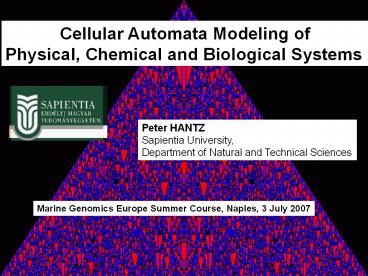Cellular Automata Modeling of - PowerPoint PPT Presentation
1 / 15
Title:
Cellular Automata Modeling of
Description:
Cellular Automata Modeling of Physical, Chemical and Biological Systems Peter HANTZ Sapientia University, Department of Natural and Technical Sciences – PowerPoint PPT presentation
Number of Views:166
Avg rating:3.0/5.0
Title: Cellular Automata Modeling of
1
Cellular Automata Modeling of Physical, Chemical
and Biological Systems
Peter HANTZ Sapientia University, Department of
Natural and Technical Sciences
Marine Genomics Europe Summer Course, Naples, 3
July 2007
2
space
Game on a String
Two States 0 (black) and 1 (white)
time
Neighborhood 3 cells
A Transition Rule 2 x 2 x 28 possibilities have
to be specified
- 3 Black White
- 2 Black Black
- 1 Black Black
- 3 White White
Generic Rule
3
Denomination of the Rules Wolfram
Convention current pattern
111 110 101 100 011 010 001 000 new state
for center cell 0 1 1 1
1 1 1 0 In binary notation
0 26 25 24 23 22 21 0
126 Possible patterns
Outputs 2 x 2 x 2 x 2
x 2 x 2 x 2 x 2 256
gt256 possible general rules
4
A Game or Something More?
http//www.ifi.unizh.ch/ailab/teaching/FG05/script
/FM3-CA.pdf
Sierpinski triangle a fractal
I. a trivial state
II. simple or periodic structures
III. chaotic structures
IV. complex migrating structures
5
Game on a 2D grid
Neumann Neighborhood
Moore Neighborhood
NN - Possibilities to be specified 25 32 gt
Number of Possible Rules 232 huge
6
Simple totalistic rules Conways Game of Life
(Moore Nbh.)
Any live cell with fewer than 2 live neighbors
dies, as if by loneliness. Any live cell with
more than 3 live neighbors dies, as if by
overcrowding. Any live cell with 2 or 3 live
neighbors lives, unchanged, to the next
generation. Any empty (dead) cell with exactly
3 live neighbors comes to life.
Features of the Game of Life
Steady objects Oscillators Gliders
and Spaceships
7
CA in Biology/Chemistry Excitable Media
Greenberg-Hastings Model cells with several
states
Q one quiescent state E1Ee e excited
states R1Rr r refractory states Rules Q
?E1 when a NN is excited excited cells
Ek?Ek1, Ee ?R1 refractory cells Rk ?Rk1,
Rr ?Q
Weimar, 1998
http//psoup.math.wisc.edu/java/jgh.html
Bub et al., 1998
BZ Reaction
8
CA in Physics/Biology Growth Phenomena
diffusion-limited aggregation
Particles (blue) move randomly in the grid. When
a blue particles touches a green solid particle,
it also turns green and "sticks. Particle
density (parameter) a percentage, saying
what fraction of sites will contain blue
particles at the beginning. The shape of the
branching structure (fractal) depends on the
initial density of blue particles.
http//germain.umemat.maine.edu/faculty/hiebeler/j
ava/CA/DLA/DLA.html
Ben-Jacob et al., 1994
9
CA in Physics Traffic modeling Nagel-Schreckenber
g model a probabilistic cellular automaton
The street is divided into cells, that may
contain cars with velocity v
Step 1 acceleration All cars that have not already reached the maximal velocity vmax, accelerate by one unit v -gt v1
Step 2 safety distance If a car has d empty cells in front of it, and its velocity is v larger then d, it reduces the velocity to d v -gtmind,v
Step 3 randomization With probability p, the velocity is reduced by one unit v -gt v-1
Step 4 drivingCar n moves forward vn cells xn -gt xnvn.
http//www.thp.uni-koeln.de/as/Mypage/traffic.htm
l
Cyclic boundary conditions
10
Traffic modeling continued
http//www.grad.hr/nastava/fizika/ole/simulation.h
tml
green v4, khaki v3, brown v2, yellow v1,
red v0
Having p0 second-order phase transition at a
critical car density
Poore, 2006
11
Self-reproduction The Idea of János NEUMANN, in
1948, before the discovery of the DNA! gt
development of the Cellular Automata Science
Langtons loop
http//necsi.org/postdocs/sayama/sdsr/
8 states, 29 rules
Tempesti, 1998
12
Self-reproduction with Evolution? Artificial
Life, Evoloop
Collision of two SR loops may lead to third,
different SR loop Hurted SR loops may
disappear Smaller individuals were naturally
selected? Or just fragmentation?
http//necsi.org/postdocs/sayama/sdsr/
13
So, what are cellular automata?
Dynamical System a rule that describes the time
evolution of the state (x) of an arbitrary
system The system state at time t is a
description of the system which is sufficient to
predict the future states of the system without
recourse to states prior to t. Continuous in
state and time differential equations Dis
crete in state and time cellular automata
x(t1)f(x(t))
Some Special Behavior of Dynamical
Systems Fixed point x(t1)x(t) for all
tgtt0 Limit cycle x(tk)x(t) for all tgtt0
14
Separating Length Scales combining CA and
Differential Equations
Hantz, 2002
15
Thank You!































